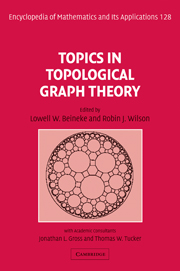Book contents
- Frontmatter
- Contents
- Foreword
- Preface
- Introduction
- 1 Embedding graphs on surfaces
- 2 Maximum genus
- 3 Distribution of embeddings
- 4 Algorithms and obstructions for embeddings
- 5 Graph minors: generalizing Kuratowski's theorem
- 6 Colouring graphs on surfaces
- 7 Crossing numbers
- 8 Representing graphs and maps
- 9 Enumerating coverings
- 10 Symmetric maps
- 11 The genus of a group
- 12 Embeddings and geometries
- 13 Embeddings and designs
- 14 Infinite graphs and planar maps
- 15 Open problems
- Notes on contributors
- Index
13 - Embeddings and designs
Published online by Cambridge University Press: 05 June 2012
- Frontmatter
- Contents
- Foreword
- Preface
- Introduction
- 1 Embedding graphs on surfaces
- 2 Maximum genus
- 3 Distribution of embeddings
- 4 Algorithms and obstructions for embeddings
- 5 Graph minors: generalizing Kuratowski's theorem
- 6 Colouring graphs on surfaces
- 7 Crossing numbers
- 8 Representing graphs and maps
- 9 Enumerating coverings
- 10 Symmetric maps
- 11 The genus of a group
- 12 Embeddings and geometries
- 13 Embeddings and designs
- 14 Infinite graphs and planar maps
- 15 Open problems
- Notes on contributors
- Index
Summary
When a graph is embedded in a surface, the faces that result can be regarded as the blocks of a combinatorial design. The resulting design may be thought of as being embedded in the surface. This perspective leads naturally to a number of fascinating questions about embeddings, in particular about embeddings of Steiner triple systems and related designs. Can every Steiner triple system be embedded, can every pair of Steiner triple systems be biembedded, and how many embeddings are there of a given type?
Introduction
In this section we define the terminology taken from combinatorial design theory and summarize some of the basic results. Before doing this, we remark that the study of the relationship between block designs and graph embeddings dates back to Heffter, who in 1891 realized the connection between two-fold triple systems and surface triangulations. Later work in this field was done by Emch [27], Alpert [2], White [57], Anderson and White [6], Anderson [4], [5], Jungerman, Stahl and White [40], Rahn [54], and more recently White [58]. These authors considered various aspects of the above relationship, including embeddings into closed surfaces, pseudosurfaces and generalized pseudosurfaces, embeddings of balanced incomplete block designs (BIBDs) with block size greater than 3, and the symmetry properties of the resulting embeddings. However, the material we survey in this chapter is mainly, although not exclusively, concerned with embeddings of Steiner triple systems in both orientable and non-orientable surfaces. Embeddings in pseudosurfaces and generalized pseudosurfaces will not be considered.
Information
- Type
- Chapter
- Information
- Topics in Topological Graph Theory , pp. 268 - 288Publisher: Cambridge University PressPrint publication year: 2009
Accessibility standard: Unknown
Why this information is here
This section outlines the accessibility features of this content - including support for screen readers, full keyboard navigation and high-contrast display options. This may not be relevant for you.Accessibility Information
- 1
- Cited by
